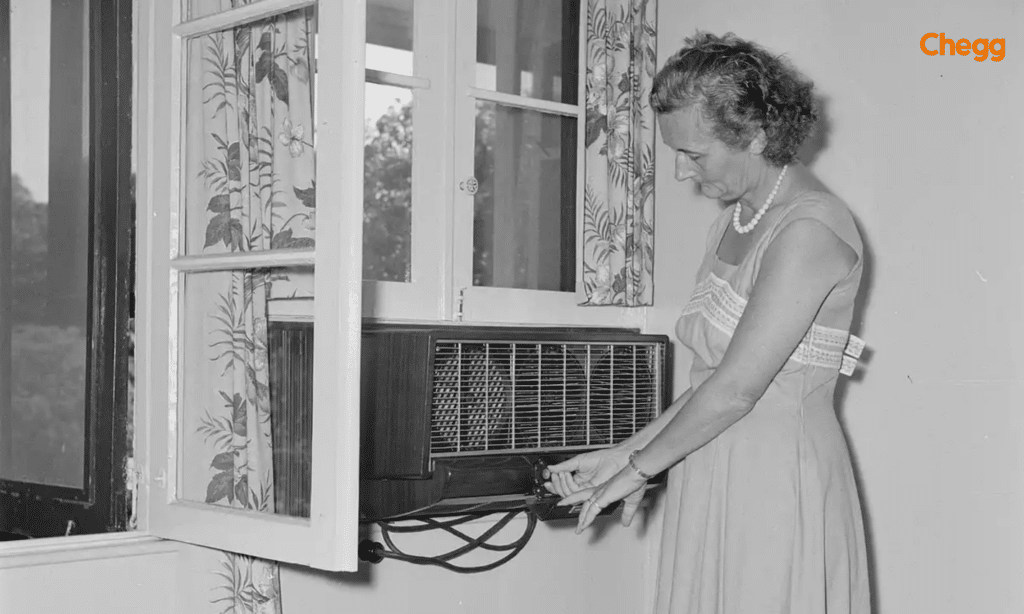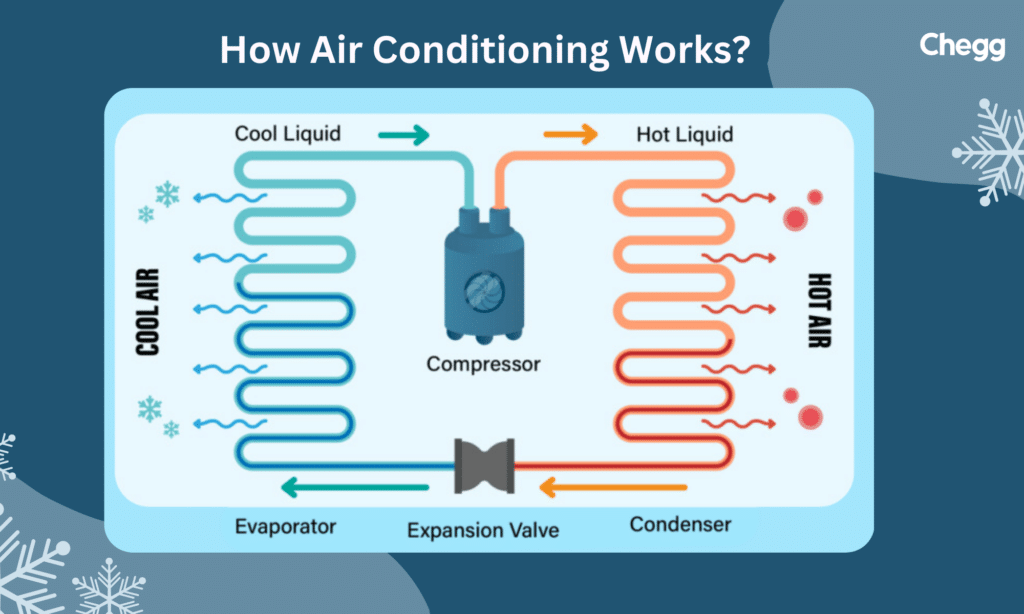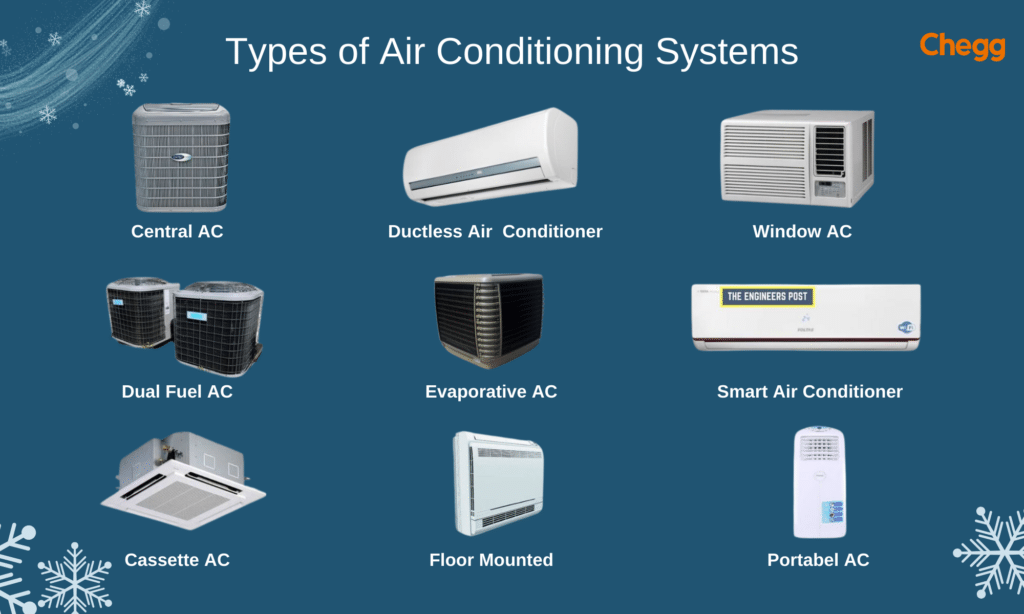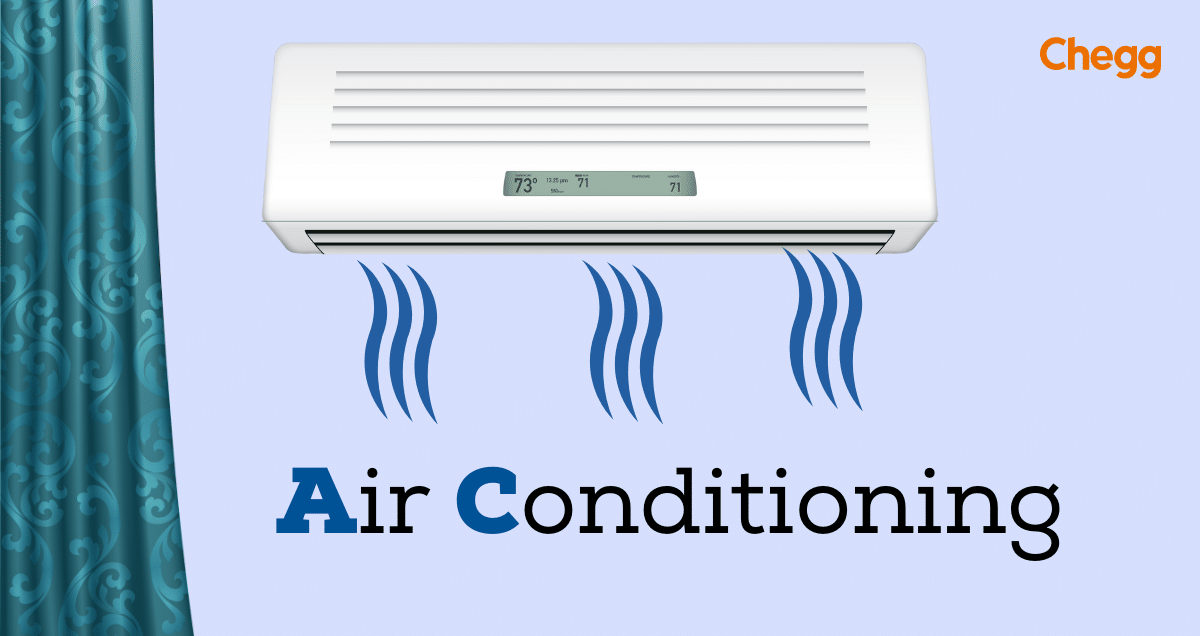Table of Contents
AC Full Form
AC full form is Air Conditioning, is a vital technology in today’s world, especially in areas with hot summers or high humidity. It’s designed to cool and dehumidify indoor air, making living and working spaces more comfortable.
The main job of air conditioning is to remove heat from inside, which helps maintain cooler temperatures when it’s hot outside. It works by passing air over coils filled with refrigerant. As the warm air moves over these coils, the refrigerant absorbs heat, cooling the air before it’s released back into the room.
Modern AC systems often include features like air purification and humidity control, which not only enhance comfort but also improve air quality. These advancements have made air conditioning essential for homes, offices, and various other environments, ensuring better living conditions and increased productivity.
AC Full Form in Hindi
The full form of AC in Hindi is “एयर कंडीशनर” (Air Conditioner).
Historical Evolution of Air Conditioning (AC)

The journey to cool down spaces has a long history, leading to today’s air conditioner. Here’s how it evolved:
Early Efforts (Before Electricity):
- Ancient Times (2nd Century China): People used hand-operated fans and evaporation methods to cool air.
- Romans: The Frigidarium in Roman baths offered a cool retreat after hot baths.
Birth of Modern AC (Early 1900s):
- 1748: William Cullen (Scotland) experimented with cooling using evaporation and refrigeration ideas.
- 1851: John Gorrie (USA) created a machine with a steam engine for air cooling, but it wasn’t widely adopted.
- 1902: Willis Carrier (USA) invented the first electric air conditioning unit. Originally for a printing plant, it controlled both temperature and humidity.
Growth and Popularization (Mid-1900s):
- 1919: Air conditioning became popular in movie theaters, providing relief during hot summers.
- 1932: H.H. Schultz and J.Q. Sherman developed the first window AC unit, making cooling more accessible despite high costs at first.
- 1947: Henry Galson improved window AC units, making them smaller and cheaper, leading to more homes having AC.
Advancements Post-World War II (Late 1900s):
- 1960s: Japan introduced mini-split AC systems for efficient cooling in smaller homes.
- 1970s & 1980s: Advances in multi-zone and variable refrigerant flow systems provided more flexible and efficient cooling choices.
Today and Beyond (21st Century):
- Focus on Efficiency: AC units now use less energy with better insulation and inverter technology.
- Smart AC Systems: These can be controlled remotely and scheduled for comfort and energy savings.
- Environmentally Friendly: New AC units use eco-friendly refrigerants that are better for the environment.
Willis Carrier is known as the “father of modern AC,” but its development owes much to earlier innovations and continues to improve with efficiency, comfort, and environmental concerns in mind.
How Air Conditioning (AC) Works?

Principles of Heat Transfer
Air Conditioning (AC full form) operates based on the principles of heat transfer. It involves the transfer of heat from a space with a lower temperature (indoors) to a space with a higher temperature (outdoors). This is achieved through various processes, including conduction, convection, and radiation.
Components of an Air Conditioning System
An Air Conditioning (AC full form) system has several key components that provide cooling. These components include:
- Compressor: The compressor plays a crucial role in the refrigeration cycle. It compresses the refrigerant gas, increasing its temperature and pressure.
- Condenser: The condenser allows the hot refrigerant gas to dissipate heat to the surroundings. It cools and condenses the refrigerant, transforming it into a high-pressure liquid.
- Evaporator: The evaporator is responsible for absorbing heat from the indoor air. As the liquid refrigerant expands and evaporates in the evaporator coil, it absorbs heat, cooling the surrounding air.
- Expansion Valve: The expansion valve regulates refrigerant flow from the high-pressure liquid state to the low-pressure liquid state, allowing it to evaporate in the evaporator.
Cooling Process:
- Heat Absorption: Warm indoor air is drawn in and passes over the evaporator coil. The refrigerant inside absorbs heat from the air, making it cooler. The refrigerant evaporates (turns into gas) as it absorbs heat.
- Compression: The low-pressure gas goes to the compressor. The compressor squeezes the gas, making it hot and high-pressure.
- Heat Release: The hot, high-pressure gas moves to the condenser coil outside. A fan blows air over the coil, releasing heat into the outdoor air. This cools the refrigerant, turning it back into a liquid.
- Repeat Cycle: The cooled liquid refrigerant returns to the evaporator coil to absorb more heat from indoor air. This cycle continues to cool your home.
Additional Parts:
- Thermostat: Controls the AC by turning it on and off to keep your home at the desired temperature.
- Air Filter: Removes dust and allergens from the air before it circulates in your home.
Overall, air conditioning cools your home by moving heat from inside to outside, creating a comfortable environment.
Types of Air Conditioning (AC) Systems

Air Conditioning (AC full form) systems come in different types, each suited for various needs and settings:
Window Air Conditioners:
- These units are self-contained and fit into a window or a specially made hole in a wall. They are compact and generally used for cooling single rooms or small spaces.
Split Air Conditioners:
- Consisting of 2 units—an indoor unit containing the evaporator coil and an outdoor unit housing the compressor and condenser coil—split ACs are versatile and can cool multiple rooms depending on the model.
Central Air Conditioning:
- Typically used for larger buildings or homes, central AC systems use ducts to distribute cooled air throughout the entire building from a central unit located outside or in a basement.
Portable Air Conditioners:
- These units are mobile and can be moved from room to room. They vent hot air through a window or wall and are suitable for cooling individual rooms without the need for installation.
Ductless Mini-Split Systems:
- Similar to split ACs but without ducts, these systems have an outdoor compressor unit connected to one or more indoor air-handling units. They offer flexibility and efficiency for cooling specific zones or rooms.
Each type of air conditioning system has its advantages depending on factors like space size, installation flexibility, and cooling efficiency, making it important to choose the right one for your needs.
Benefits of Air Conditioning (AC)
Air Conditioning (AC full form) offer many benefits that make our lives more comfortable and healthier:
- Improved Comfort: Air conditioning keeps us cool and comfy, especially in hot and humid summers. It helps us relax, sleep better, and be more productive indoors.
- Enhanced Air Quality: AC units can make indoor air cleaner by:
- Filtering out dust, pollen, and allergens with air filters.
- Reducing humidity levels, making the air feel less sticky and preventing mold growth.
- Healthier Environment: Keeping indoors cool helps prevent heat-related illnesses like heat stroke. It also promotes better sleep, which boosts energy levels and mood.
- Increased Productivity: Cooler environments improve cognitive and physical performance, making it easier to focus and work effectively.
- Protection for Electronics and Furniture: AC maintains stable indoor conditions that prevent damage to electronics and furniture caused by heat and humidity.
- Year-Round Comfort: Some AC units also work as heaters, ensuring comfort during colder seasons too.
- Noise Reduction: AC units can help reduce outside noise by sealing your home more effectively.
Overall, air conditioners are essential for creating a comfortable, healthy, and productive indoor environment, improving our quality of life throughout the year.
Applications of Air Conditioning (AC)
Air Conditioning (AC full form) is important in many areas beyond just keeping homes comfortable. Here are some key uses:
Comfort Cooling:
- Homes: AC keeps houses cool during hot weather.
- Commercial Buildings: Offices, malls, and restaurants use AC to make spaces comfortable for workers and customers, improving productivity and satisfaction.
Environmental Control for Sensitive Applications:
- Data Centers: AC prevents computers from overheating, ensuring they work smoothly. Maintaining a cool and stable environment ensures smooth operation and protects vital data.
- Hospitals: AC keeps operating rooms and labs clean and safe by controlling temperature and humidity.
- Museums: AC preserves artworks from heat and moisture by maintaining stable temperature and humidity levels.
Industrial Processes:
- Manufacturing: Many industrial processes require specific temperature and humidity controls for efficient production and product quality. Air conditioning helps maintain these precise conditions.
- Food Processing: AC is crucial in food plants to keep products safe by refrigerating them properly.
Specialized Uses:
- Transportation: AC is vital in cars, airplanes, and trains. It also helps prevent overheating of sensitive electronic components.
- Telecommunication: AC cools telecommunication equipment like cell towers and server racks, ensuring reliable network operation.
Enhancing Agriculture:
- Greenhouses: AC controls temperature and humidity for optimal plant growth, allowing year-round farming and better crop yields.
Overall, air conditioning is essential across many industries for maintaining ideal conditions for processes, products, and people’s health. As technology improves, we’ll see more ways AC can be used innovatively in the future.
Factors to Consider when Choosing an Air Conditioning (AC) System
Choosing the right Air Conditioning (AC full form) system for your home involves considering several factors to ensure it cools effectively, saves energy, and fits your budget. Here are some key points to think about:
- Size and Capacity: Measure your home’s size to determine the right cooling capacity (BTUs) needed. Too small won’t cool well, and too big wastes energy. Get help from an HVAC pro to calculate this.
- Climate: If you live where summers are hot and humid, you’ll need a system that can handle higher temperatures effectively.
- Energy Efficiency: Look for units with a high SEER rating for efficiency. This helps lower energy bills and is better for the environment.
- System Type:
- Central AC: Cools the whole house but needs ductwork.
- Ductless Mini-Splits: Good for homes without ducts or for specific zones. Offers flexible control.
- Window ACs: Cheaper for cooling one room but can be noisy and less efficient.
- Portable ACs: Easy to move around but may not cool large areas well.
- Cost: Consider upfront costs for equipment and installation, plus long-term energy savings. Efficient systems may cost more initially but save money over time.
- Additional Features:
- Noise Level: Choose quieter units, especially for bedrooms.
- Smart Features: Wi-Fi units let you control settings remotely, which can save energy.
- Air Filtration: Units with good filters improve indoor air quality.
- Professional Installation and Maintenance: Proper installation by a licensed HVAC professional ensures your AC works well. Regular maintenance keeps it running smoothly.
By thinking about these factors and getting advice from a professional, you can pick the best AC system for your home. It’ll keep you cool, save energy, and fit your budget for a comfortable indoor environment.
Air Conditioning (AC) Innovations and Trends
The world of Air Conditioning (AC full form) is always changing to make sure it’s efficient, good for the environment, and keeps people comfortable. Here are some of the newest ideas and trends that are shaping the future of AC:
Saving Energy and Being Eco-Friendly:
- New HVAC systems are being made with things like variable-speed compressors and zoned cooling. These help use less energy while still keeping things comfy.
- AC units are starting to use refrigerants that don’t hurt the environment as much, which is good for the planet.
- Some AC systems now use power from the sun, so they don’t need as much electricity from power plants.
Smart Homes:
- Smart thermostats are becoming popular. They let you control your AC from far away using your phone or other smart devices.
- You can even tell some systems what to do using your voice with things like Google Assistant or Amazon Alexa.
Better Comfort and Air Quality:
- Some ACs now clean the air as they cool. They can take out things like dust and allergens, which can help you stay healthier.
- ACs are also getting better at taking the humidity out of the air. This can make hot places feel more comfy and stop mold from growing.
Cooling Made Just for You:
- Systems that let you change the temperature in different parts of your home are becoming more common. This saves energy by only cooling the rooms that people are using.
- Other systems use one outdoor unit with many indoor units to keep each room just the right temperature.
New Technology:
- Inverter technology is being used more. It changes how fast the compressor works to use less energy, make less noise, and keep the temperature steady.
- ACs might start to connect to the internet in the future. This would let them be fixed from far away, tell when they need upkeep, and show how well they’re working in real time.
These new ideas show that ACs are getting better at saving energy, being good for the environment, and making sure everyone stays comfortable. As time goes on, we can expect even more cool things to come from air conditioning.
Air Conditioning (AC) Health and Safety Considerations
When it comes to Air Conditioning (AC full form), several health and safety considerations should be kept in mind:
Indoor Air Quality
- Indoor air quality depends on air conditioning. Cleaning or replacing filters regularly removes airborne pollutants and allergens, improving indoor air quality.
Mold and Moisture Control
- Mold and mildew growth require humidity control. Air conditioning reduces mold growth, which can cause respiratory problems and allergies.
Proper Ventilation
- Fresh air and indoor pollution prevention require adequate ventilation. Proper air conditioning ventilation removes stale air and brings in fresh air.
Common Air Conditioning (AC) Problems and Solutions
Here are some common issues your air conditioner might face and what you can do about them:
Lack of Cool Air:
- Possible Causes:
- Dirty Air Filter: A clogged air filter restricts airflow, reducing cooling efficiency.
- Low Refrigerant Level: Leaking or low refrigerant can significantly affect cooling capacity.
- Frozen Coil: Restricted airflow or low refrigerant can cause the evaporator coil to freeze, preventing proper cooling.
- Thermostat Malfunction: A faulty thermostat might not be registering the correct temperature, preventing the AC from turning on or cooling adequately.
- Solutions:
- Clean or replace the air filter regularly.
- Do not attempt to fix refrigerant leaks yourself. Call a qualified technician for repair and proper refrigerant recharge.
- Turn off the AC and allow the ice to melt completely before restarting. If the freezing recurs, consult an HVAC professional.
- Check the thermostat settings and ensure it’s functioning correctly. If needed, replace the thermostat.
Water Leaks:
- Possible Causes:
- Clogged Drain Line: A clogged condensate drain line can lead to water backing up and leaking indoors.
- Dirty Drain Pan: A dirty drain pan can prevent proper drainage, causing overflow.
- Damaged Drain Line: Cracks or breaks in the drain line can also cause leaks.
- Solutions:
- Clean the condensate drain line by following the manufacturer’s instructions.
- Clean the drain pan to ensure proper water flow.
- For damaged drain lines, call a professional for repair or replacement.
Unusual Noises:
- Possible Causes:
- Loose Parts: Vibrations from loose screws or components can create noise.
- Worn Belt (Belt-driven systems): A worn belt can cause squeaking or grinding noises.
- Dirty Fan: A dirty fan can become unbalanced and noisy.
- Solutions:
- Tighten any loose screws or components according to the user manual.
- For belt-driven systems, replace a worn belt with a new one of the same specifications.
- Clean the fan blades to remove dust and debris. Consult the user manual for specific cleaning instructions.
AC Not Turning On:
- Possible Causes:
- Tripped Circuit Breaker: A tripped breaker due to overloaded circuits can prevent the AC from starting.
- Blown Fuse: A blown fuse in the AC unit itself might be the culprit.
- Thermostat Malfunction: A faulty thermostat might not be sending a signal to turn on the AC.
- Solutions:
- Check your home’s circuit breaker panel and reset any tripped breakers.
- If a fuse has blown, replace it with a fuse of the same amperage rating. Consult a qualified technician if you’re unsure about fuse replacement.
- Ensure the thermostat is set to “cool” mode and the desired temperature is lower than the room temperature.
Remember, for complex issues or tasks involving refrigerant or electrical parts, it’s best to get help from a qualified HVAC technician to ensure safe and proper repairs.
Conclusion
Now you know the AC Full Form (Air Conditioning), basically it improves indoor air quality, comfort, and productivity. Whether in residential, commercial, industrial, or automotive applications, air conditioning systems offer temperature control, energy efficiency, and the maintenance of optimal indoor conditions. From the early cooling methods to the latest innovations, air conditioning has evolved significantly. Its role in maintaining a comfortable and healthy living and working environment cannot be overstated, making it an essential aspect of our modern lifestyles.
AC Full Form: Key Takeaways
- AC stands for Air Conditioning, which cools indoor air for comfort.
- AC units cool air by removing heat and humidity, using a refrigeration process.
- Includes window units, splits, central systems, and portable units, each with different uses.
- Keeps indoor spaces cool and comfortable during hot weather.
- Newer AC units save energy, reducing electricity bills.
- Regular upkeep ensures AC units work well and last longer.
- Proper disposal and eco-friendly refrigerants help protect the environment.
- Understanding AC helps choose the right type for comfort and efficiency.
- Using AC responsibly saves energy and money while keeping indoor spaces cool.
Learn more about some other full forms:
| NFT Full Form | PLC Full Form | NVM Full Form |
| JPEG Full Form | SEO Full Form | TCP Full Form |
| SaaS Full Form | DSC Full Form | GIF Full Form |
Ready to learn more? Click on below button to get the complete list of Full Forms!
AC Full Form: FAQs
How often should I schedule maintenance for my air conditioning system?
It is recommended to schedule annual maintenance for your air conditioning system.
Can I install an air conditioning system myself?
It is advisable to hire a professional to install an air conditioning system.
What is the average lifespan of an air conditioning unit?
The average lifespan of an air conditioning unit is approximately 10 to 15 years.
Should I cover my outdoor AC unit during the winter?
Covering the outdoor AC unit during winter is generally recommended to protect it from debris and harsh weather conditions.
How do I know if my air conditioning system needs refrigerant recharge?
A refrigerant recharge may be necessary if your air conditioning system is not cooling properly or there has been a noticeable decline in performance.
Got a question on this topic?
